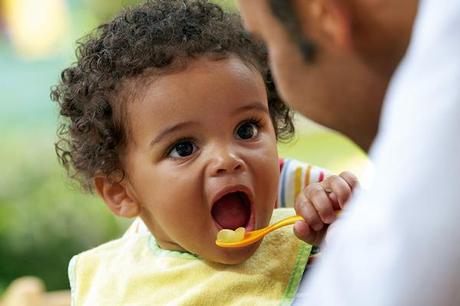
There comes a time in every baby’s life when the food on your plate starts to look more appealing than what she’s been eating. Is it time to start feeding your baby solid foods?Here are a few things to think about:
- Is your baby around 6 months old?
- Can she sit up with support and hold her head up by herself?
- Does she show interest in solid foods, for example, by watching you when you eat and opening her mouth or moving it as though she was chewing?
- When you offer her a spoonful, does she take it into her mouth and move her jaw rather than pushing it out with her tongue?
- Has she doubled her birth weight (about 13 pounds or more)?
- Is she still hungry after a full feed of breast milk or formula?
If the answer to these questions is yes, your baby might be ready to enter the world of solid foods.
First foodsIn the past, parents were advised to start with a single-grain cereal and introduce solid foods in a specific order: rice cereal, vegetables, fruits, then meat. We now know that there’s no scientific evidence to show that introducing foods in a specific order is necessary. Of course, it's fine to introduce foods in the traditional order if you prefer, but if you think your baby is interested in trying a different food first, that’s alright as well.The following guidelines do still apply:
- Introduce new foods one at a time, and wait two to three days between each new food to watch for an allergic reaction, such as diarrhoea, a rash, or vomiting.
- Even though it’s called solid food, your baby’s first foods won’t actually be solid at all. Instead, the foods will be soft or pureed -- i. e. what we generally think of as baby food and find in little jars at the supermarket. If you like, you can also puree food in a blender or food processor. Just make sure everything is reduced down to the point that it no longer requires any chewing. You can also try mixing in a bit of breast milk or formula to make your baby’s first solid foods taste more familiar.
- Offer small bites - half a spoonful or a bit on the end of your fingertip is enough. And don’t expect your little one to start feeding herself yet. That will come later when she’s ready for finger foods.
- If your baby turns her nose up, don’t force the issue. Go back to breast milk or formula for a little while longer. There’s plenty of time for your baby to learn to enjoy solid foods.
- Don’t forget breast milk or formula. Just because your baby has started on solid foods doesn’t mean she’s ready to be weaned off milk. On the contrary, breast milk and/or formula will continue to be an important part of your baby’s diet until she’s at least 12 months old.
As you start feeding your baby solid foods, remember that mealtimes aren't just for eating -- they're important social times as well. So as your little one takes her first tastes, make it a family affair and enjoy your meal together.
Bon appétit!
By Jane Chou for Love Sleep Play
Love Sleep Play: Baby Love & Care


